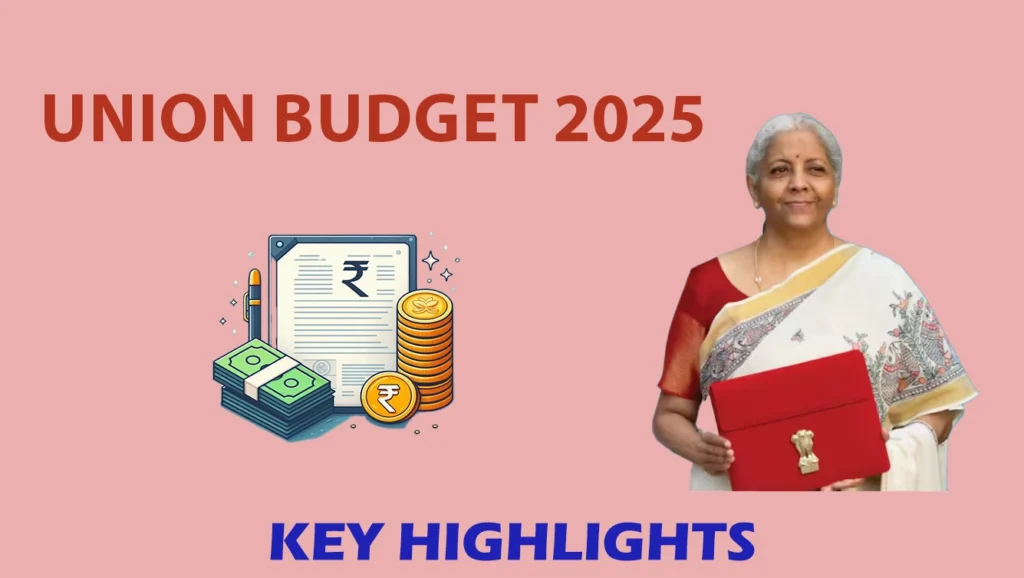Last updated on April 22nd, 2025 at 02:33 am
The Union Budget 2025, presented by Finance Minister Nirmala Sitharaman, marks a bold step towards shaping India’s economic future.
With the global economy facing a volatile landscape, India continues to push forward with reforms aimed at fostering inclusive growth, enhancing infrastructure, and modernizing the tax system. The budget focuses on simplifying processes, boosting rural resilience, and promoting innovation across sectors.
Let’s dive into the most significant changes that are shaping India’s future in 2025.

1. Simplified Taxation for Individuals
One of the standout reforms in the 2025 budget is the introduction of the Income Tax Bill, 2025.
This new law will replace the existing Income Tax Act of 1961 and is designed to make tax compliance easier for individuals and businesses alike.
The new law eliminates outdated provisions, reducing complexity by as much as 60%, and introduces clearer definitions, such as replacing the terms “assessment year” and “previous year” with a simple concept of “tax year.”
In terms of direct benefits for taxpayers, the revised tax slabs bring relief to individuals. The new tax regime offers the following structure:
- Up to ₹4,00,000: No tax
- ₹4,00,001 to ₹8,00,000: 5%
- ₹8,00,001 to ₹12,00,000: 10%
- ₹12,00,001 to ₹16,00,000: 15%
- ₹16,00,001 to ₹20,00,000: 20%
- ₹20,00,001 to ₹24,00,000: 25%
- Above ₹24,00,000: 30%
This reform is further strengthened by a substantial increase in the rebate under Section 87A, from ₹25,000 to ₹60,000, allowing individuals earning up to ₹12,00,000 to benefit from a complete tax rebate.
2. Boost to Healthcare
In response to the growing demands of the healthcare sector, the Union Budget 2025 has significantly increased funding for health programs.
The budget allocation for health has risen by 191% from ₹34,286 crore in 2014-15 to ₹99,858 crore for 2025-26. This increase aims to improve healthcare accessibility and infrastructure across India.
Additionally, life-saving drugs have received a major boost, with 36 drugs now fully exempt from basic customs duty, while six others will benefit from a concessional 5% customs duty. This step will make essential medicines more affordable for the masses.
3. Support for Agriculture and Rural Development
India’s agricultural sector continues to be a focus in the 2025 budget. The government has announced the launch of a National Mission on High Yielding Seeds, which will focus on developing climate-resilient, pest-resistant, and high-yielding varieties of seeds.
This initiative aims to enhance food security and the productivity of Indian farmers.
Additionally, the government has introduced the Rural Prosperity and Resilience Program. This program seeks to tackle rural underemployment through skill development initiatives and technology adoption.
By targeting rural women, young farmers, and small landholders, the government aims to boost incomes and create sustainable employment opportunities in India’s villages.
A particularly noteworthy initiative is the establishment of the Makhana Board, which aims to promote the cultivation and marketing of fox nuts (makhana). This sector currently employs over 10 lakh people, and the new board will provide necessary support to sustain and grow this vital agricultural enterprise.
4. Gig Economy and Worker Security
With the rise of the gig economy, the 2025 budget includes provisions to secure the welfare of gig workers.
These workers, who contribute significantly to sectors like food delivery, transportation, and freelancing, will now be eligible for social security benefits, including insurance coverage up to ₹1 crore.
This move is expected to provide a safety net for millions of gig workers who have previously lacked adequate social security protections, contributing to a more equitable and inclusive economy.
5. Infrastructure and Investment in Connectivity
The budget places a strong emphasis on improving India’s infrastructure. The government has committed to further investment in roads, railways, ports, and airports, all of which will facilitate economic growth by improving connectivity and reducing bottlenecks.
Moreover, the budget focuses on increasing public-private partnerships to ensure the efficient utilization of resources, with special attention given to the development of smart cities and green infrastructure.
These initiatives will help India stay ahead in the global race for economic modernization while addressing environmental concerns.
6. Financial Sector Reforms
To bolster India’s financial resilience, the government has announced plans to implement a Mission for Cotton Productivity.
This five-year mission will support cotton farmers with new techniques, training, and technology to boost productivity, particularly in regions where cotton is a key crop.
Additionally, efforts will be made to improve the availability of affordable credit to farmers, startups, and small businesses through enhanced access to digital financial services. By fostering financial inclusion, India aims to make its financial sector more robust and competitive.
Conclusion
India’s Union Budget 2025 is a forward-looking document that reflects the government’s commitment to economic growth, inclusivity, and sustainability.
With its emphasis on tax simplification, healthcare expansion, rural development, and worker security, the budget aims to empower India’s middle class, stimulate rural economies, and address the challenges of a changing world.
As the government takes steps toward modernizing the tax system, bolstering infrastructure, and improving the lives of its citizens, India is positioning itself for a more resilient and prosperous future.
The path ahead looks promising, and the budget reforms in union budget are sure to leave a lasting impact on the country’s trajectory.
Pingback: Capital Gain Tax Rates in India: Types, Rates, Exemption - Fil Zill